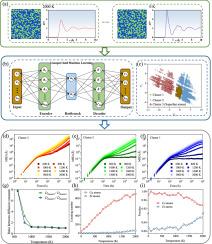The emergent correlation between unstable modes and superfast atoms in Cu50Zr50 glassy system
IF 2.9
Q2 MATERIALS SCIENCE, MULTIDISCIPLINARY
引用次数: 0
Abstract
In recent work [Yang et al., Acta. Mater 281, 120410 (2024)], the rational structural representation of superfast “liquid-like” atoms in glasses was identified as ”cluster 3” via the unsupervised machine learning algorithm. Here, we further elucidate the connection of these superfast atoms to unstable instantaneous modes with imaginary frequencies (negative eigenvalues of the Hessian matrix), reflecting to transient saddle points on the potential energy landscape and thus potentially driving fast relaxations. Importantly, the localized unstable modes are characterized and found closely related to sub-picosecond lifetime. Moreover, the modified participation ratio is proposed to specifically evaluate the contribution to unstable modes, revealing that cluster 3, i.e., superfast atoms shows significant coupling to unstable and localized modes, as evidenced by the remarkably high level of . This work establishes the emergent correlation among atomic structure, vibrational spectroscopy and relaxation phenomena in disordered materials.

Cu50Zr50玻璃体系中不稳定模与超快原子之间的新兴关联
在最近的研究中[Yang et al., Acta.]Mater 281, 120410(2024)],通过无监督机器学习算法将玻璃中超高速“类液体”原子的合理结构表示识别为“簇3”。在这里,我们进一步阐明了这些超快原子与具有虚频率(Hessian矩阵的负特征值)的不稳定瞬时模式的联系,这些模式反射到势能图上的瞬态鞍点,从而潜在地驱动快速弛豫。重要的是,局部不稳定模式的特征和发现密切相关的亚皮秒寿命。此外,提出了修正的参与比ξω,iimag来具体评估对不稳定模式的贡献,表明簇3即超快原子与不稳定模式和局域模式具有显著的耦合,这一点可以从非常高的ξω,iimag水平上得到证明。这项工作建立了无序材料中原子结构、振动光谱和弛豫现象之间的紧急关联。
本文章由计算机程序翻译,如有差异,请以英文原文为准。
求助全文
约1分钟内获得全文
求助全文
来源期刊

Materialia
MATERIALS SCIENCE, MULTIDISCIPLINARY-
CiteScore
6.40
自引率
2.90%
发文量
345
审稿时长
36 days
期刊介绍:
Materialia is a multidisciplinary journal of materials science and engineering that publishes original peer-reviewed research articles. Articles in Materialia advance the understanding of the relationship between processing, structure, property, and function of materials.
Materialia publishes full-length research articles, review articles, and letters (short communications). In addition to receiving direct submissions, Materialia also accepts transfers from Acta Materialia, Inc. partner journals. Materialia offers authors the choice to publish on an open access model (with author fee), or on a subscription model (with no author fee).
 求助内容:
求助内容: 应助结果提醒方式:
应助结果提醒方式:


